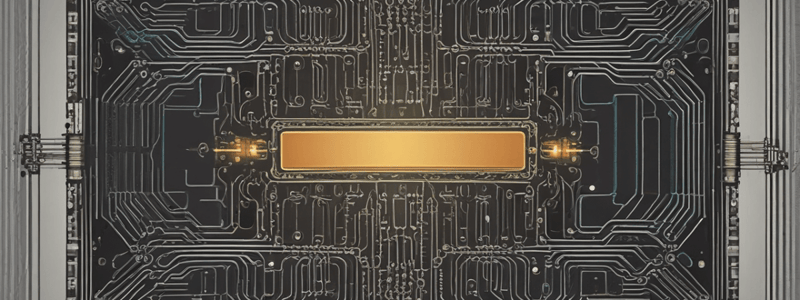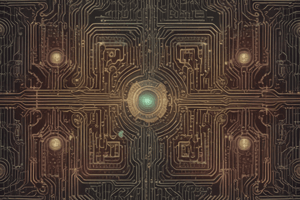Podcast
Questions and Answers
What is the primary purpose of developing Low-Power TTL?
What is the primary purpose of developing Low-Power TTL?
- To enhance the functionality of TTL gates
- To address the power consumption issues of standard TTL (correct)
- To increase the speed of TTL gates
- To reduce the cost of TTL devices
Which type of TTL incorporates Schottky diodes in the circuitry?
Which type of TTL incorporates Schottky diodes in the circuitry?
- Fast TTL
- Schottky TTL (correct)
- Advanced Schottky TTL
- Low-Power TTL
What is the characteristic of Schottky TTL devices?
What is the characteristic of Schottky TTL devices?
- Faster switching speeds and higher power consumption
- Higher power consumption and slower switching speeds
- Faster switching speeds and lower power dissipation (correct)
- Slower switching speeds and lower power consumption
What is the significance of the part number '74LS00' in the context of TTL?
What is the significance of the part number '74LS00' in the context of TTL?
What is the primary improvement of Advanced Schottky TTL over Schottky TTL?
What is the primary improvement of Advanced Schottky TTL over Schottky TTL?
Which type of TTL is an extension of Schottky TTL?
Which type of TTL is an extension of Schottky TTL?
What is the primary difference between Schottky TTL and Advanced Schottky TTL?
What is the primary difference between Schottky TTL and Advanced Schottky TTL?
Which of the following is NOT a characteristic of Low-Power TTL?
Which of the following is NOT a characteristic of Low-Power TTL?
What is the significance of the part number '74S00' in the context of TTL?
What is the significance of the part number '74S00' in the context of TTL?
Which type of TTL is not mentioned in the passage?
Which type of TTL is not mentioned in the passage?
Flashcards are hidden until you start studying
Study Notes
Basic Logic Circuits
- Basic logic circuits are fundamental building blocks of digital electronics
- They perform logical operations using binary signals (0s and 1s)
- Examples of basic logic circuits include:
- NOT Gate (Inverter)
- AND Gate
- OR Gate
- NAND Gate
- NOR Gate
- XOR Gate (Exclusive OR)
- XNOR Gate (Exclusive NOR)
- Buffer
Logic Gate Characteristics
- Each type of gate has specific characteristics that define its behavior
- Examples include:
- NOT Gate: outputs the complement of the input
- AND Gate: outputs high (1) only when all inputs are high (1)
- OR Gate: outputs high (1) when at least one input is high (1)
- NAND Gate: outputs low (0) only when all inputs are high (1)
- NOR Gate: outputs low (0) when at least one input is high (1)
- XOR Gate: outputs high (1) when the number of high inputs is odd
- XNOR Gate: outputs high (1) when the number of high inputs is even
Propagation Delay
- Propagation delay is a crucial parameter in digital circuits that measures the time taken for a signal to travel from the input of a logic gate to its output
- Factors affecting propagation delay include:
- Transistor characteristics
- Load capacitance
- Technology node
- Temperature
- Voltage levels
- Importance of propagation delay:
- Speed of operation
- Signal integrity
- Maximum operating frequency
- Timing analysis
- Power consumption
NMOS Inverter
- An NMOS inverter is a fundamental building block in digital circuit design
- It performs the logical operation of inversion, where the output is the complement of the input
- The NMOS inverter is commonly used in CMOS technology
- Characteristics of the NMOS inverter include:
- Inversion
- Pull-down network
- Ground-referenced output
- Logic levels
NMOS Logic Gates
- NMOS logic gates are basic building blocks in digital circuit design
- They are used in CMOS technology to implement digital circuits
- Examples of NMOS logic gates include:
- NMOS Inverter (NOT Gate)
- NMOS NOR Gate
- NMOS NAND Gate
- Characteristics of NMOS logic gates include:
- Inversion
- Pull-down network
- Ground-referenced output
- Logic levels
CMOS Inverter
- A CMOS inverter is a fundamental building block in digital integrated circuits
- It is composed of both NMOS and PMOS transistors, arranged in a complementary fashion
- Characteristics of the CMOS inverter include:
- Complementary operation
- Low power consumption
- High noise margins
- Symmetric voltage transfer characteristic
- Wide fan-out
- Fast switching speeds
CMOS Logic Gates
-
CMOS logic gates are essential building blocks in digital integrated circuits
-
They are designed using a combination of NMOS and PMOS transistors, operating in a complementary manner
-
Examples of CMOS logic gates include:
- CMOS Inverter
- CMOS NAND Gate
- CMOS NOR Gate
- CMOS AND Gate
- CMOS OR Gate
-
Characteristics of CMOS logic gates include:
- Low power consumption
- High noise margins
- Efficient operation
- Wide fan-out
- Balanced operation### CMOS and BJT Logic Gates
-
CMOS logic gates are basic building blocks for designing complex digital systems and are widely used in integrated circuits, microprocessors, memory devices, and other digital applications.
-
BJT (Bipolar Junction Transistor) inverter is a fundamental building block in digital electronics.
-
A BJT inverter converts a high input to a low output and vice versa, commonly used to invert the logic level of a signal.
BJT Inverter Circuit (NPN Transistor)
- The circuit consists of a single NPN transistor, resistors for biasing, and operates as follows:
- High input: current flows through the base resistor, saturating the transistor, and pulling the output voltage to a low level.
- Low input: minimal current flows through the base resistor, cutting off the transistor, and allowing the output voltage to be pulled high through the collector resistor.
Characteristics of BJT Inverter
- Performs inversion, converting a high input to a low output and vice versa.
- Logic levels are determined by the supply voltage and voltage drop across the collector-emitter path.
- Proper biasing is essential to ensure the transistor operates in the active region.
- Limitations include power consumption and speed compared to modern technologies like CMOS.
- Applications include analog circuits and amplifiers, with signal amplification as a secondary function.
TTL (Transistor-Transistor Logic)
- TTL is a type of digital logic family widely used in electronic circuits.
- Characteristics:
- Bipolar technology using BJTs as primary switching elements.
- Operates with two voltage levels: HIGH (2.4V-5V) and LOW (0V-0.8V).
- Limited fan-out, meaning it can only drive a certain number of inputs.
- Logic levels are well-defined, with moderate noise immunity.
- Power consumption is significant, especially when driving multiple inputs.
- Speed is generally slower than modern technologies like CMOS.
TTL Logic Gates
- NAND gates are a type of digital logic gate that performs the logical operation "NOT-AND".
- Operation: produces a HIGH output only when at least one input is LOW.
- Can be implemented using various technologies, such as transistors or electronic components like diodes and resistors.
NAND Gate Implementation
- CMOS implementation: uses NMOS and PMOS transistors to perform the NAND operation.
- Characteristics:
- Universal gate, meaning any other logic gate can be constructed using only NAND gates.
- Complement output, providing the inverse of the AND operation.
- Multiple inputs, with the output remaining the same: LOW only when all inputs are HIGH.
- Common usage: widely used in digital circuits for various purposes, including building blocks for more complex logic circuits.
TTL Output Characteristics
- Voltage levels: HIGH (2.4V-5V) and LOW (0V-0.8V).
- Current sinking: TTL outputs can actively pull current to ground when providing a logic LOW.
- Fan-out: limited, especially when driving other TTL gates.
- Output impedance: relatively low, allowing TTL gates to drive low-impedance loads effectively.
- Output current (IOH and IOL): specified in the datasheet, crucial for understanding the ability of the gate to drive loads.
- Noise margin: well-defined HIGH and LOW logic levels with specified noise margins.
- Power consumption: significant, especially during transitions between logic levels.
- Propagation delay: relatively low, with temperature dependence affecting the characteristics.
Studying That Suits You
Use AI to generate personalized quizzes and flashcards to suit your learning preferences.





